Smart organizations in baseball are able to assemble a durable and talented roster each season. Exceptional organizations are able to do that while maintaining a consistent pipeline of talented players who can contribute within the next 5 years. The St. Louis Cardinals once fell into the latter group.
The 2024 starting rotation is a splattering of veterans who have been acquired largely via free agency. In fact, only one player, Lance Lynn, is "homegrown" of the bunch, and the Cardinals had to re-acquire him this offseason through free agency. Sonny Gray, Miles Mikolas, Steven Matz, and Kyle Gibson all became Cardinals through free agency at different points in the last 5 years.
Building a starting rotation through free agency isn't inherently a bad thing; it's just an expensive way to go about business. Paying tens of millions of dollars for pitchers who are worth 2-3 wins above replacement is fiscally foolish when young pitchers can be developed and be just as effective. The Cardinals have been unable to develop those mid-rotation starters in recent years, and that has hurt the team.
I wanted to take a look back to the last time the Cardinals had a top-10 rotation. Using Baseball-Reference WAR, the last time the Cardinals had a team in the top 10 of baseball was in 2018. That year, the rotation was led by Miles Mikolas, Jack Flaherty, John Gant, Carlos Martinez, Luke Weaver, and Michael Wacha. Since then, the rotation has ranked far below league average according to bWAR.
Miles Mikolas was the only free-agent, non-homegrown player on that list. Today, every starting pitcher in the rotation was brought on via free agency. A lot has changed in only 5 years.
Let's assume that the DeWitt family and John Mozeliak are forward-looking people who make plans for the future. If this is the case, surely they were looking at the prospects and development of young pitchers to continue filling spots in the rotation like Martinez, Weaver, Flaherty, and Wacha did in 2018.
The DeWitt family is known for pinching pennies, so one can assume that they would prefer filling out a rotation with arbitration and pre-arbitration players who are cheap rather than veteran free agents who can cost tens of millions of dollars. The plan for future rotations was apparent in 2019 and 2020. That plan, however, did not come to fruition for a variety of reasons.
